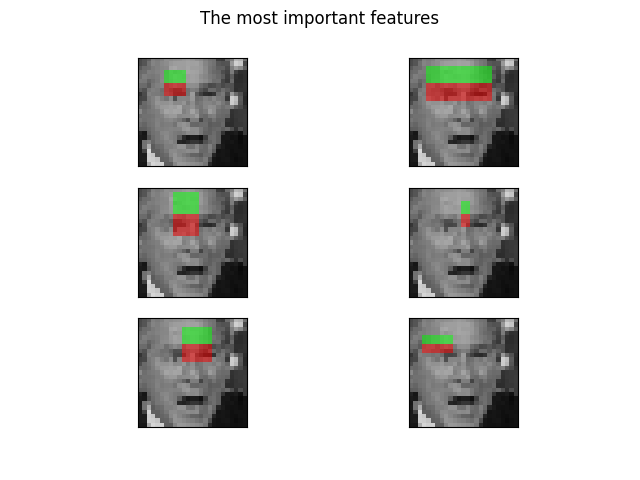Note
Go to the end to download the full example code or to run this example in your browser via Binder.
Face classification using Haar-like feature descriptor#
Haar-like feature descriptors were successfully used to implement the first real-time face detector [1]. Inspired by this application, we propose an example illustrating the extraction, selection, and classification of Haar-like features to detect faces vs. non-faces.
Notes#
This example relies on scikit-learn for feature selection and classification.
References#
from time import time
import numpy as np
import matplotlib.pyplot as plt
from sklearn.ensemble import RandomForestClassifier
from sklearn.model_selection import train_test_split
from sklearn.metrics import roc_auc_score
import skimage as ski
The procedure to extract the Haar-like features from an image is relatively simple. Firstly, a region of interest (ROI) is defined. Secondly, the integral image within this ROI is computed. Finally, the integral image is used to extract the features.
def extract_feature_image(img, feature_type, feature_coord=None):
"""Extract the haar feature for the current image"""
ii = ski.transform.integral_image(img)
return ski.feature.haar_like_feature(
ii,
0,
0,
ii.shape[0],
ii.shape[1],
feature_type=feature_type,
feature_coord=feature_coord,
)
We use a subset of CBCL dataset which is composed of 100 face images and 100 non-face images. Each image has been resized to a ROI of 19 by 19 pixels. We select 75 images from each group to train a classifier and determine the most salient features. The remaining 25 images from each class are used to assess the performance of the classifier.
images = ski.data.lfw_subset()
# To speed up the example, extract the two types of features only
feature_types = ['type-2-x', 'type-2-y']
# Compute the result
t_start = time()
X = [extract_feature_image(img, feature_types) for img in images]
X = np.stack(X)
time_full_feature_comp = time() - t_start
# Label images (100 faces and 100 non-faces)
y = np.array([1] * 100 + [0] * 100)
X_train, X_test, y_train, y_test = train_test_split(
X, y, train_size=150, random_state=0, stratify=y
)
# Extract all possible features
feature_coord, feature_type = ski.feature.haar_like_feature_coord(
width=images.shape[2], height=images.shape[1], feature_type=feature_types
)
A random forest classifier can be trained in order to select the most salient features, specifically for face classification. The idea is to determine which features are most often used by the ensemble of trees. By using only the most salient features in subsequent steps, we can drastically speed up the computation while retaining accuracy.
# Train a random forest classifier and assess its performance
clf = RandomForestClassifier(
n_estimators=1000, max_depth=None, max_features=100, n_jobs=-1, random_state=0
)
t_start = time()
clf.fit(X_train, y_train)
time_full_train = time() - t_start
auc_full_features = roc_auc_score(y_test, clf.predict_proba(X_test)[:, 1])
# Sort features in order of importance and plot the six most significant
idx_sorted = np.argsort(clf.feature_importances_)[::-1]
fig, axes = plt.subplots(3, 2)
for idx, ax in enumerate(axes.ravel()):
image = images[0]
image = ski.feature.draw_haar_like_feature(
image, 0, 0, images.shape[2], images.shape[1], [feature_coord[idx_sorted[idx]]]
)
ax.imshow(image)
ax.set_xticks([])
ax.set_yticks([])
_ = fig.suptitle('The most important features')

We can select the most important features by checking the cumulative sum of the feature importance. In this example, we keep the features representing 70% of the cumulative value (which corresponds to using only 3% of the total number of features).
cdf_feature_importances = np.cumsum(clf.feature_importances_[idx_sorted])
cdf_feature_importances /= cdf_feature_importances[-1] # divide by max value
sig_feature_count = np.count_nonzero(cdf_feature_importances < 0.7)
sig_feature_percent = round(sig_feature_count / len(cdf_feature_importances) * 100, 1)
print(
f'{sig_feature_count} features, or {sig_feature_percent}%, '
f'account for 70% of branch points in the random forest.'
)
# Select the determined number of most informative features
feature_coord_sel = feature_coord[idx_sorted[:sig_feature_count]]
feature_type_sel = feature_type[idx_sorted[:sig_feature_count]]
# Note: it is also possible to select the features directly from the matrix X,
# but we would like to emphasize the usage of `feature_coord` and `feature_type`
# to recompute a subset of desired features.
# Compute the result
t_start = time()
X = [extract_feature_image(img, feature_type_sel, feature_coord_sel) for img in images]
X = np.stack(X)
time_subs_feature_comp = time() - t_start
y = np.array([1] * 100 + [0] * 100)
X_train, X_test, y_train, y_test = train_test_split(
X, y, train_size=150, random_state=0, stratify=y
)
712 features, or 0.7%, account for 70% of branch points in the random forest.
Once the features are extracted, we can train and test a new classifier.
t_start = time()
clf.fit(X_train, y_train)
time_subs_train = time() - t_start
auc_subs_features = roc_auc_score(y_test, clf.predict_proba(X_test)[:, 1])
summary = (
f'Computing the full feature set took '
f'{time_full_feature_comp:.3f}s, '
f'plus {time_full_train:.3f}s training, '
f'for an AUC of {auc_full_features:.2f}. '
f'Computing the restricted feature set took '
f'{time_subs_feature_comp:.3f}s, plus {time_subs_train:.3f}s '
f'training, for an AUC of {auc_subs_features:.2f}.'
)
print(summary)
plt.show()
Computing the full feature set took 18.733s, plus 1.660s training, for an AUC of 1.00. Computing the restricted feature set took 0.097s, plus 1.466s training, for an AUC of 1.00.
Total running time of the script: (0 minutes 24.525 seconds)
